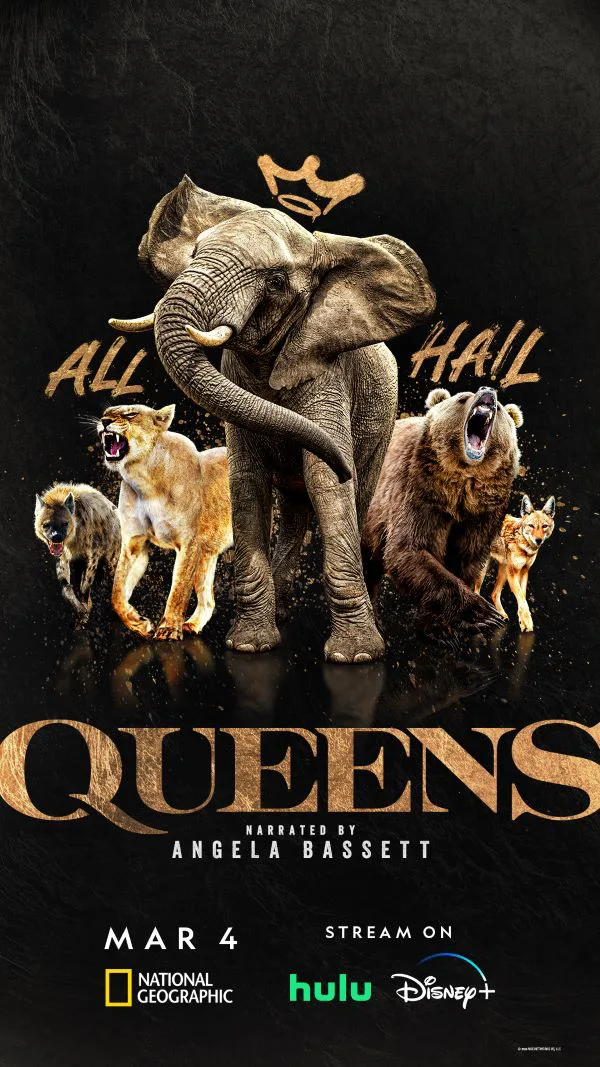The shots are unreal. We fly behind and next to a bee in the jungle. We see lust on a young bonobo’s face. We watch lions and hyenas fight over a carcass in the middle of the night. National Geographic’s “Queens” delivers the nature documentary goods, and while watching it, I couldn’t stop wondering how they’d captured so much stunning footage.
Thankfully the seven-part series ends with a behind-the-scenes look at the Angela Bassett–narrated and executive-produced series. In it, we learn that women directed all of the episodes of “Queens,” capturing footage across four years. The production paired experienced filmmakers with their rising peers, recruiting directors in the countries in which they filmed.
The result is an intimate portrayal of creatures ranging in size from ants to elephants. We learn about their social structures, familial bonds, mating habits, gender dynamics, and more.
As such, “Queens” hits all the regular beats of its genre. Climate change is threatening these unique and captivating animals’ very existence. Ditto for development that is shrinking their habitats. And of course, the natural world is unforgiving if not cruel. Outside of the handful of animals who get eaten, we see many species kill their own, usually with a male destroying the offspring of a rival, despite the mother’s best efforts to stop him. Lions, bears, orcas, monkeys, they all do this, with bee and hyena matriarchs getting in on the infanticide. It’s a reminder that humans aren’t the only ones who kill our own kind.
The show doesn’t draw that particular conclusion, but it does seem to imply that animal mothers offer us meaningful models of feminine leadership—and that idea doesn’t work. The selected animals’ matriarchal societies aren’t “new” like the opening monologue insists. Elephants and the rest have been led by the female of their species since time immemorial.
Moreover, these female animals do not offer a kinder or different model of leadership than species with male leaders. We literally watch a hyena kill a pup—her niece no less—in her bid to take leadership of the pack! Animals can be ruthless, female or not. The only possible exception here is the bonobos. “Queens” notes that they are the least violent and most playful of all primates—and the only ones led by females. They also don’t have to fight for food, living in a jungle where there’s plenty for everyone. But the show doesn’t investigate what came first—their peaceful way of life, their feminine leadership, or their relative prosperity.
Instead, “Queens” is more interested in amping up the drama in ways that pander to a feminist-light, girlboss type of sensibility. For example, the show features a variety of over-the-top musical cues that had me laughing at rather than with “Queens.” Do we need countless songs playing on the word “queens” and applying our pop culture understanding of that word (and “mother” in the very cool Gen Z sense) to be fascinated by the natural world? No, we do not. Also, throwing in tracks like a remake of Destiny Child’s “Survivor” as a wolf learns to make it without her pack is so on the nose as to be silly.
“Queens” also puts human value judgments on its animal subjects in a way that feels false. Would it be terrible for a human mother to eat her daughter’s eggs and replace them with her own? Yes—although it’s hard to imagine how that’d work. But is it morally wrong for a queen bee to do? I’m not so sure. Also, tearing off a limb to survive is a big deal when you’re a homo sapien, but maybe when you’re a queen ant, it’s just part of life.
I know they need to construct plot arcs out of years of material, but laying tense or joyous music behind the footage and pairing it with a silly script, that Basset does her best with, doesn’t do it. It would have been better to present some of the animals’ ways as biological curiosities or fascinating animal behaviors rather than morality plays.
Still, it is worth remembering that science has largely ignored the female of the species—and that has real-world effects, particularly in medicine. So there is value in this project’s focus on female animals, and its approach of recruiting women directors, and local ones at that, further underscores the point. Our modern human society is still lacking in feminine perspectives behind and in front of the camera, the microscope, and the park ranger badge—all points that “Queens” makes well.
I wish “Queens” had focused on those points rather than asking me to relate to the inexperience of a first-time elephant mother or the tough love of a fox matriarch, assuming I have more in common with her than her male counterpart because of our respective sex organs. It’s a bit of gender essentialism that undercuts the beautiful artistry and important science in this otherwise highly enjoyable series.
On Disney+ now.




















